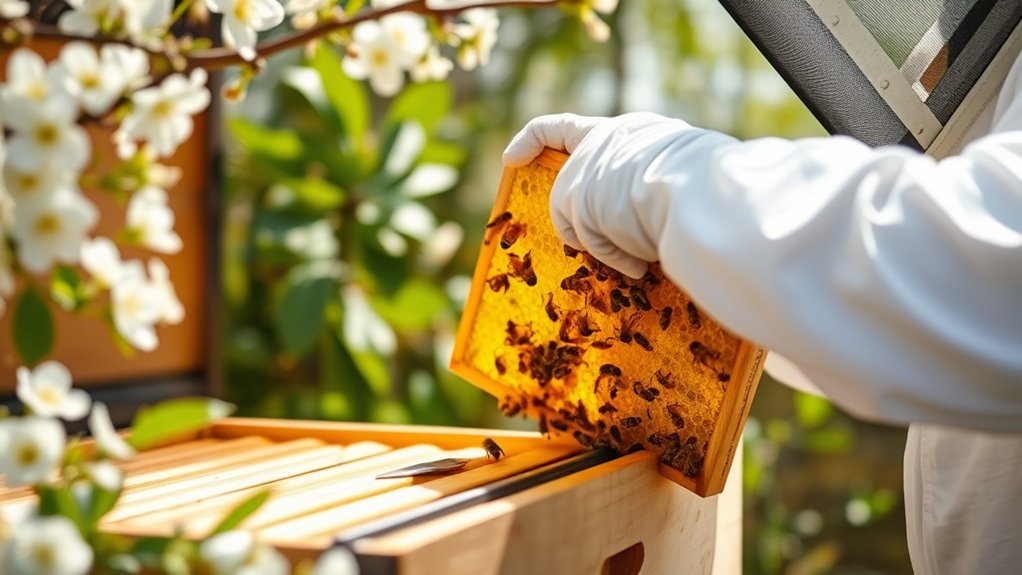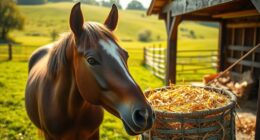To start small-scale beekeeping, choose a sunny, sheltered spot with good airflow and elevate your hive off the ground using natural materials. In spring, check your hive regularly for signs of healthy brood, add supers to accommodate growth, and manage pests organically. During summer, ensure bees have water and shade, monitor for pests, and provide sugar if needed. Prepare for fall by reducing entrances and securing honey stores. Continue exploring these practices to keep your colony thriving year-round.
Key Takeaways
- Choose a sunny, sheltered, and elevated location using natural materials to promote hive health and sustainability.
- Regularly inspect hives for queen activity, colony growth, pests, and disease signs, adding supers as needed.
- Provide shade, water, and ventilation during summer, and reduce hive entrances in fall to prevent pests and conserve warmth.
- Avoid chemicals by implementing organic pest control and natural remedies, maintaining hive balance and resilience.
- Focus on long-term health through early detection, proper management, and environmentally conscious hive placement.

Small-scale beekeeping offers a rewarding way to connect with nature while producing your own honey. When setting up your hive, it’s vital to focus on sustainable practices that promote the health of your bees and the environment. Choose a suitable location that offers sunlight, some shade during the hottest part of the day, and protection from strong winds. Elevate your hive off the ground to prevent moisture buildup and discourage pests. Using natural materials for hive components, like untreated wood or cedar, can help maintain hive health and reduce chemical exposure. Proper ventilation is essential, so ensure your hive has enough space for airflow, which helps regulate temperature and humidity levels, supporting healthy bee activity year-round.
As you establish your hive, you’ll want to pay close attention to seasonal management. In the spring, check your hive regularly to assess the queen’s laying pattern and ensure the colony is expanding. Add supers (additional boxes) as needed to give your bees room to grow, but avoid overcrowding, which can lead to swarming. During this period, implement sustainable practices like avoiding unnecessary chemical treatments and using organic methods to control pests such as varroa mites. Maintaining hive health involves monitoring for signs of disease or distress, such as abnormal brood patterns or dead bees, and intervening promptly with natural remedies or consulting experienced beekeepers. Keeping your hive clean and free of debris also minimizes disease risks.
In summer, your focus should shift to ensuring your bees have enough water and shade during the hottest days. Regularly inspect for pests and parasites, and consider integrated pest management strategies that prioritize bees’ well-being. Managing hive ventilation becomes critical, particularly during heatwaves, to prevent overheating. If you notice signs of stress or declining hive health, take immediate action to address the problem rather than delaying treatment or resorting to harsh chemicals. Feeding your bees supplementary sugar syrup during nectar dearths can help sustain the colony, but do so carefully to avoid encouraging robbing behavior from neighboring hives.
As fall approaches, prepare your hive for winter by reducing entrances to keep out rodents and ensuring the bees have sufficient honey stores. Avoid overharvesting honey, leaving enough for the colony’s winter needs, which supports sustainable practices and hive health through the colder months. Monitor the hive’s insulation and ventilation, adjusting as necessary to prevent moisture buildup. Regular, gentle inspections during this time help you catch problems early and ensure your bees are ready to survive the winter. Maintaining a balance between intervention and natural resilience is key to successful small-scale beekeeping, fostering healthy colonies and sustainable practices that benefit both you and your environment.
Frequently Asked Questions
What Are the Best Beginner-Friendly Bee Breeds for Small-Scale Beekeeping?
For beginners, choosing hardy bee breeds like Carniolans, Buckfasts, or Italians is ideal. You should focus on queen bee selection to guarantee a gentle, productive hive. These breeds are resilient and easier to manage, with drone bee roles that support healthy hive growth. Their temperament and adaptability make them perfect for small-scale beekeepers, helping you enjoy your first seasons without much hassle.
How Do I Handle Bee Stings Safely and Effectively?
Did you know that most bee stings are harmless, but proper handling is essential? To handle bee stings safely, quickly remove the stinger with a scraping motion, avoid squeezing to prevent venom injection, and apply a cold pack to reduce swelling. Always keep a first aid kit nearby, and practice sting prevention by wearing protective gear and working calmly. Stay attentive, and you’ll minimize discomfort and risks effectively.
What Are Common Pests and Diseases Affecting Small Apiaries?
You should regularly check your hive for common pests and diseases like mite infestations and fungal infections. Mites, such as varroa mites, weaken bees and spread viruses, so use approved treatments and monitor mite levels. Fungal infections can cause hive rot or brood disease; make certain of good ventilation and hygiene to prevent these issues. Promptly identify and treat problems to keep your bees healthy and thriving.
How Can I Improve Honey Harvest Quality and Quantity?
To boost honey quality and quantity, focus on enhancing nectar sources nearby and maintaining excellent hive hygiene. While some think extra intervention isn’t needed, regular inspections prevent pests and diseases that can reduce harvests. By providing diverse nectar sources through planting flowering plants and ensuring your hive stays clean and disease-free, you create ideal conditions for bees to produce abundant, high-quality honey. Consistent effort pays off with better yields.
What Local Regulations Should I Be Aware of for Beekeeping?
You should check your local zoning laws to guarantee beekeeping is allowed in your area. Additionally, you’ll likely need to obtain apiary permits from your city or county authorities before setting up your hives. Contact your local government or agricultural office to get specific regulations, including hive placement distances and number limits. Staying compliant helps you avoid fines and ensures a positive relationship with your neighbors.
Conclusion
Now that you know how to set up your hive and manage it through the seasons, you’re ready to start your small-scale beekeeping journey. For example, imagine a hobbyist in Oregon who successfully boosts her hive’s productivity by adjusting her management practices as seasons change. By staying attentive and adapting, you can create a thriving hive, even in limited space. With dedication, you’ll enjoy the rewards of healthy bees and sweet honey.









